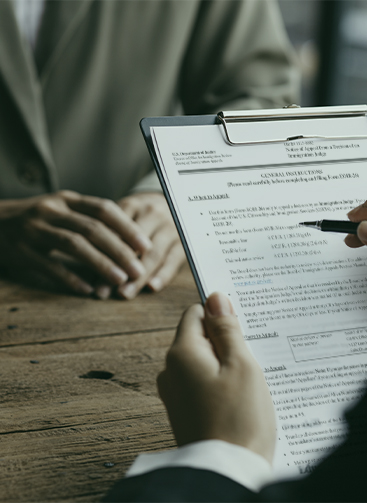MON – FRI (8am - 6pm)
Defensive asylum is a request for protection presented as a defense against deportation from the U.S. This process is initiated when a person is placed in removal proceedings before an immigration judge of the Executive Office for Immigration Review (EOIR), typically after being apprehended for immigration violations.
This process takes place in an adversarial setting where the applicant must prove that they face persecution in their home country. The immigration judge evaluates the evidence presented and decides whether to grant asylum or not. If you are looking for the best attorneys in defensive asylum, contact us.


A defensive asylum application occurs when the applicant requests asylum as a defense against deportation from the U.S. The individual must be in removal proceedings in immigration court with the Executive Office for Immigration Review (EOIR).
Typically, individuals are placed into defensive asylum processing in one of the following two ways: first, they are referred to an immigration judge by USCIS after being found ineligible for asylum; second, they are placed in removal proceedings due to immigration violations.
Immigration judges hear defensive asylum cases in adversarial proceedings. The judge will hear arguments from both parties: you (and your attorney) and the U.S. government, represented by an attorney from U.S. Immigration and Customs Enforcement (ICE).
The credible fear evaluation begins with an interview to determine if the applicant has a well-founded fear of persecution or torture.
See questions and answers about credible fear here.
It is recommended to organize all necessary documents and be prepared to provide detailed and accurate information about your fear of persecution or torture in your home country.
During the interview, an asylum officer will ask detailed questions to evaluate your credible fear. Ensure that you respond honestly and thoroughly. The interview can last several hours, and it is crucial to remain calm and consistent in your responses.

Affirmative asylum and defensive asylum are two different ways for a person to request protection in the United States. Affirmative asylum is requested directly through the United States Citizenship and Immigration Services (USCIS) when the applicant is not in removal proceedings. On the other hand, defensive asylum is presented as a defense in the context of removal proceedings before an immigration judge of the Executive Office for Immigration Review (EOIR).
In the affirmative process, the applicant has a non-adversarial interview with an asylum officer. If the application is denied, the case may be referred to an immigration judge for a defensive asylum hearing. Conversely, in the defensive process, the applicant must appear before an immigration judge, where the hearing is adversarial, involving evidence, testimonies, and arguments from both the applicant and the government's attorney.
Defensive asylum requests may be denied, in which case the applicant can appeal if they wish. The following lines will explain more about this.
To appeal a denied defensive asylum, you must file a notice of appeal with the Board of Immigration Appeals (BIA) within 30 days of the judge's decision. It is essential to follow all specific procedures.
You must complete Form EOIR-26, Notice of Appeal to the Board of Immigration Appeals, to initiate the appeal process. This form must be submitted along with the required fee or a request for a fee waiver. See how form EOIR-26 looks
Once the notice of appeal is filed, you will have the opportunity to submit a brief detailing the reasons for your appeal. It is crucial to present strong arguments and supporting documentation.

When an applicant does not qualify for affirmative asylum, USCIS refers them to an immigration judge of the EOIR. This typically happens if USCIS determines, after a non-adversarial interview, that the applicant does not meet the requirements for asylum and is present illegally in the country. If you need legal advice, contact serving immigrants
The transfer of asylum applications to an immigration judge can also occur when a person is detained for immigration violations. In these situations, ICE or CBP can place the individual in removal proceedings. The process involves issuing a Notice to Appear and transferring any pending asylum application to the immigration court for further review.
To apply for defensive asylum, several critical documents are needed to support your case. These documents include proof of identity, evidence of persecution, and documentation of your immigration status.
Passport, identity card, birth certificate, or other official documents that confirm your identity.
Form I-589, Application for Asylum and for Withholding of Removal, is used by individuals seeking asylum in the U.S. due to persecution based on race, religion, nationality, social group, or political opinion. See how it looks.
Police reports, medical evidence of injuries, photographs, testimonies, letters, and other documents that demonstrate your fear of persecution in your home country.
Witness letters, reports from human rights organizations, and evidence of affiliation with political or social groups that strengthen your story.
Tickets, entry stamps to the U.S., or any document related to your travel from your home country to the U.S.
Tourist visa, student visa, or any other document that shows your current immigration status.
Notices to Appear (NTA) or other documents related to any previous contact with the U.S. immigration legal system.
A written statement detailing the reasons for your asylum application and any other relevant information for your case.
Obtain the form from the USCIS website. Make sure you have the most recent version.
Fill out all sections of the form with accurate and detailed information.
Include copies of documents that support your application, such as proof of identity and evidence of persecution.
Retain a complete copy of the form and all submitted documents for your records.
If applicable, include the payment for the necessary fees or a request for a fee waiver.
If possible, seek legal advice to ensure your application is complete and accurate. In serving immigrants, we have an expert attorney for your case.
Inform USCIS of any changes in your address or personal situation during the process.
The Master Calendar Hearing is the initial stage where the immigration judge will review the charges against the asylum seeker. The judge will confirm the accuracy of these charges and ask if the individual wishes to apply for asylum, withholding of removal, or CAT protection.
This is a detailed hearing where the judge evaluates the asylum seeker's claim. The asylum seeker presents their story, provides evidence, and may call witnesses. The judge then determines the eligibility for asylum based on the presented evidence and testimonies.
If the asylum application is denied, both the asylum seeker and DHS have the right to appeal the decision to the Board of Immigration Appeals (BIA). During the appeal process, detailed legal arguments and additional documentation can be submitted to support the asylum claim.
In this FAQ section, the most common questions about defensive asylum are addressed, excluding those already answered throughout the article:
A defensive asylum application is filed during removal proceedings in immigration court with the Executive Office for Immigration Review (EOIR).
Yes, you can include your family members. According to U.S. immigration regulations you may include your spouse and any children under the age of 21 who are physically present in the U.S.
The process duration can vary, often taking several months to years due to court backlogs.
Having an attorney is highly recommended to navigate the complex legal process. If you need help, contact serving immigrants; we have expert attorneys in defensive asylum.
Affirmative Asylum: Application is made voluntarily to USCIS when the applicant is not in removal proceedings. Defensive Asylum: Application is made as a defense against removal when the applicant is already in removal proceedings before an immigration judge.